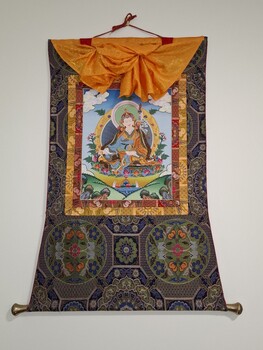Historical information
Thangkas are cloth scrolls unique to Tibetan Buddhism, depicting deities, venerated spiritual figures, or common religious symbols. Intended for personal meditation or instruction of monastic students, they are invested with the spirit of a deity to whom they are consecrated. A thangka is a composite three-dimensional object consisting of a picture panel which is painted or embroidered; a brocade mounting; and one or more of the following: a silk cover, leather corners, wooden dowels at the top and bottom and metal or wooden decorative knobs on the bottom dowel.
Significance
Guru Padmasambhava (meaning 'Lotus-born', signifying his mythical origin as a being emerging from a lotus flower), also known as Guru Rinpoche, is seen as a manifestation of Buddha Shakyamuni. He was responsible for bringing advanced Buddhist Tantric teachings to Tibet in the 8th century. His teachings and legacy are deeply ingrained in Tibetan culture.
Physical description
A Tibetan thangka depicting Guru Padmasambhava. Framed in a traditional silk brocade border; a wooden dowel is inserted in a sleeve along the bottom edge of the fabric frame.

